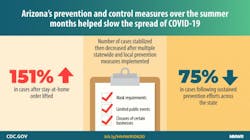CDC reports on community mitigation measures that helped slow spread of COVID-19 in Arizona
The number of COVID-19 cases in Arizona stabilized and then decreased after sustained implementation and enforcement of statewide and locally enhanced mitigation measures, beginning approximately two weeks after implementation and enforcement of mask mandates and enhanced sanitations practices began on June 17; further decreases were observed during July 13–August 7, after statewide limitations and closures of certain services and businesses.
Widespread implementation and enforcement of sustained community mitigation measures, including mask wearing, informed by state and local officials’ continual data monitoring and collaboration can help prevent transmission of SARS-CoV-2 and decrease the numbers of COVID-19 cases.
Mitigating the spread of SARS-CoV-2, the virus that causes coronavirus disease 2019 (COVID-19), requires individual, community, and state public health actions to prevent person-to-person transmission. Community mitigation measures can help slow the spread of COVID-19; these measures include wearing masks, social distancing, reducing the number and size of large gatherings, pausing operation of businesses where maintaining social distancing is challenging, working from or staying at home, and implementing certain workplace and educational institution controls.
The Arizona Department of Health Services’ (ADHS) recommendations for mitigating exposure to SARS-CoV-2 were informed by continual monitoring of patient demographics, SARS-CoV-2 community spread, and the pandemic’s impacts on hospitals. To assess the effect of mitigation strategies in Arizona, the numbers of daily COVID-19 cases and 7-day moving averages during January 22–August 7, 2020, relative to implementation of enhanced community mitigation measures, were examined. The average number of daily cases increased approximately 151%, from 808 on June 1, 2020 to 2,026 on June 15, 2020 (after stay-at-home order lifted), necessitating increased preventive measures.
On June 17, local officials began implementing and enforcing mask wearing (via county and city mandates), affecting approximately 85% of the state population. Statewide mitigation measures included limitation of public events; closures of bars, gyms, movie theaters, and water parks; reduced restaurant dine-in capacity; and voluntary resident action to stay at home and wear masks (when and where not mandated). The number of COVID-19 cases in Arizona peaked during June 29–July 2, stabilized during July 3–July 12, and further declined by approximately 75% during July 13–August 7. Widespread implementation and enforcement of sustained community mitigation measures informed by state and local officials’ continual data monitoring and collaboration can help prevent transmission of SARS-CoV-2 and decrease the numbers of COVID-19 cases.
Temporal trends were examined by comparing the number of daily COVID-19 cases (as of September 1) and 7-day moving averages before, during, and after implementation of enhanced community mitigation measures, defined as the following: limitations on persons’ time away from their place of residence except for essential activities; certain business closures and service limitations (e.g., occupancy limitations, curbside pickup, and delivery of goods); enhanced sanitation practices; social distancing, employee mask wearing, and symptom screenings for all businesses operating a physical location; limitations on the occurrence and size of public events; and local mandates enforcing mask use. The 7-day moving average was calculated after the cumulative case count exceeded 20 cases and is presented to describe COVID-19 trends.
Quantitative data on the effectiveness of community mitigation measures at suppressing the spread of COVID-19 are limited. The primary goal of implementing widespread enhanced mitigation measures in Arizona was to protect and save lives and maintain capacity in the healthcare system. A combination of voluntary and enforceable measures is more effective than any single measure. Mitigation measures mandated through public policy can effectively increase social distancing and wearing masks has prevented transmission of SARS-CoV-2.
